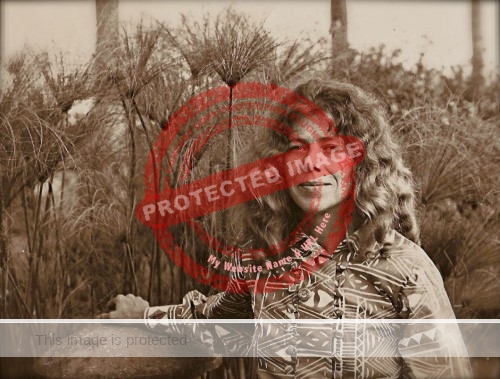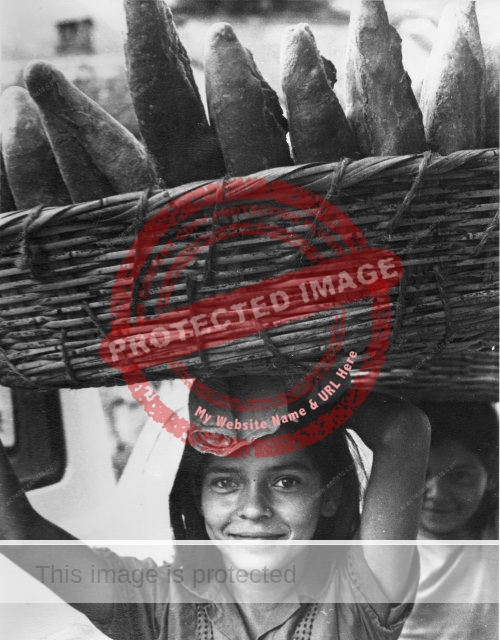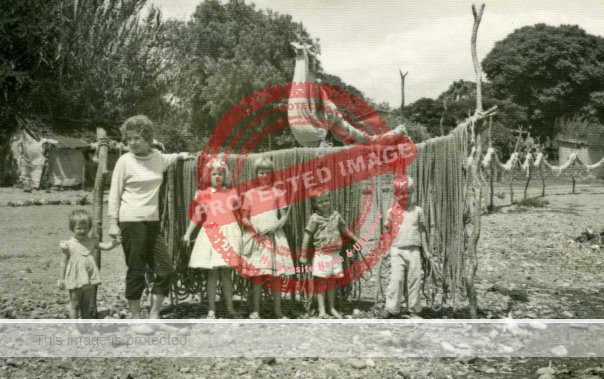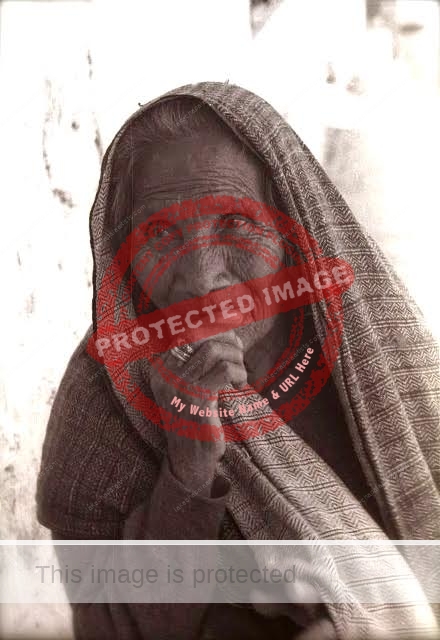Free-spirited Beverly Johnson (1933-1976), who was Ajijic’s unofficial photographer in the early 1970s, first moved to the village in 1961. She is one of the many people who helped make Ajijic tick in the old days who are really difficult to categorize.
In 1961, she extricated herself from a disastrous relationship in the U.S., shortly after the birth of her fifth child, and fled south, aiming to get her family as far away as possible from her former partner. The children were all quite young and each now recalls the details of how the family ended up in Ajijic slightly differently (not that it matters!). The romantic version is that Beverly was headed for South America when her car broke down in Guadalajara. Unable to afford the repairs, Beverly, an up-and-coming singer, asked the mechanic where she could find temporary work and was directed towards Ajijic where, the mechanic said, there was a sufficient concentration of Americans and Canadians who might appreciate her music and pay to hear her sing. And the rest, as they say, was history.
An alternative version, probably more grounded in reality, is that Beverly had heard about Ajijic, before she ever left the U.S., from Harry and Bob Stumbo, brothers from an infamous logging family in Wolf Creek, Oregon. The family stayed for about a month in Guadalajara before moving to Ajijic where the car broke down irreparably shortly after they arrived.

Photo of Beverly Johnson in Ajijic by Helen Goodridge. Reproduced by kind permission of Jill Maldonado.
Once they had settled in Ajijic, plans to venture any further south were soon forgotten. Apart from occasional visits to the coast and periodic short trips to the border to renew her tourist papers, Beverly spent the remainder of her life in Ajijic. The tenuous roots that she initially put down in Ajijic grew steadily over the years and her children have maintained ties to the village that endure to this day.
It was while living in Ajijic that Beverly became a passionate photographer and a key figure in the artistic community despite never exhibiting and rarely commercializing her work.
This means that she does not meet my rule-of-thumb criterion that profiled individuals must have gained some recognition for their art beyond the immediate environs of the lake. But rules are made to be broken (a sentiment that epitomized Beverly’s entire life) and Beverly certainly brings something different and quite special to our story of how the artistic and literary community at Lake Chapala developed.

Beverly Johnson. The Bread Girl. ca 1972. Reproduced by kind permission of Tamara Janúz.
Beverly’s corpus of photographic work is now divided between her children and friends. Despite the fact that her photos were never exhibited, she became the unofficial “photographer of record” for people and events in Ajijic during the latter part of her time in the village.
Some of her photos did make it overseas. While most of her own photos were taken in black and white and developed in her own darkroom, she also took the color photos used for international promotion by the owners of the Danza del Sol Hotel shortly after it was built. (The hotel’s architect, George Heneghan, and his wife, Molly, lived in Ajijic in the early 1970s.)
Beverly Estelle Johnson (née Hampson) was born in Grants Pass, Oregon, on 15 September 1933. She was living in Medford, Oregon, in 1961, when, lacking support from her family, she fled her husband (who was preparing to have her committed to an asylum) and drove south with her five young children (Tamara, Jill, Eric, Chris and Rachel), all under nine years of age.
They stayed a short time in Los Angeles, where Beverly hoped to make a living from her singing and guitar-playing. She recorded a promotional 45 there, but this was not an era when a single mother with five young children could find a music promoter prepared to back them. Among the other singers seeking stardom at the time was a young Joan Baez. Some years later, Beverly made a point of introducing herself to Joan Baez when she recognized her at the Beer Garden bar in Chapala.
From Los Angeles, Beverly decided to head south, and her car problems kept her in Ajijic. Beverly soon became a fixture in the village – one of the completely unconventional characters that added spice and excitement to everyday life. As her daughter Jill recalls, “She was amazing and crazy and life with her was a roller coaster ride.” Beverly used her many creative talents – as “singer, poet, writer, chef, painter, photographer and [artist of] mixed media like papier maché and rice paper balsa wood mobiles” to eke out a living for herself and her children.

Beverly Johnson and family, Ajijic beach. 1962. Photo by Saturnino ____. Reproduced by kind permission of Rachel Lyn Johnson.
When an offshoot of Timothy Leary’s group, led by Thad Ashby, arrived in Ajijic (from Zihuatanejo) in 1963-64, Beverly signed up to be a test subject (and later a monitor for tests) in the LSD “studies” conducted by Ashby’s group with the help of the University of Guadalajara Medical School. (Leary himself is said to have visited Ajijic, probably in the summer of 1964 or 1965).
Janis Carter, a family friend and child at the time, recalls how, in 1965, Beverly:
“[collected] us kids together at a big table with scissors, paintbrushes, glue, colored paper and watercolors so we could create masterpieces that she made paper frames for, and then strung them up on a line hung at Gail Michael’s shop by the Posada. She made a sign calling it a children’s sidewalk art sale and the tourists bought them up! She taught me just about everything I know about art.”
At about this time, Beverly began a lengthy relationship with a local contractor, Antonio (“Tony”) Pérez, which resulted in two more daughters (Sara and Miriam) to feed.
Beverly’s oldest daughter, Tamara, later wrote an extraordinarily revealing autobiographical short story entitled, “The Beach: My Self in the Mirror” based on a family trip to Barra de Navidad in 1964, a month after Sara’s birth. Tamara writes that the visit lasted several months and describes how the family was so poor and had so little food to eat that their mother eased their hunger pains with tiny amounts of LSD. In Tamara’s words, “‘Turning on’ has been a monthly event in my life for a couple of years”. (The younger children recall only the “occasional” use). The story has a happy ending: fortune intervenes when a fisherman lands a large fish which they cook and share.
The family visited Barra de Navidad several times, often at a moment’s notice when immigration officials arrived in Ajijic to carry out a sweep of the village for undocumented foreigners.
At one point while living in Ajijic, Beverly got into trouble with the local authorities over the upkeep of her house. Ever-resourceful, she quickly found a solution that satisfied her need for individuality. In fact, her second-eldest daughter, Jill, thinks that her mother’s response helped create the colorful village we see today:
“Miss Beverly [as she was known around town] was the first person in Ajijic to paint her house in more than two different colors. The bullies at El Municipio told her she had to paint her house or they would fine her $200.00 pesos. That being a week of groceries back then, she decided to enlist her artist friends and went around collecting any extra paint they had. Then she put us to work on that front wall: at least twenty different colors, simple long colorful stripes all the way down the wall. Those bullies were so mad at her and she simply claimed that they did not specify how to paint but just to paint. We had the very first colorful house in Ajijic and, as you can see, now that it started a trend, the whole town is painted in colors.”
In the latter part of 1969, Beverly made a trip to California to renew her tourist papers. She returned with two new loves—photography and Michael Heinichen—and promptly set up a darkroom in Ajijic where Heinichen could teach her all about photography. Her love for Heinichen did not last long (he fell in love with Laura Katzman and moved to Jocotepec) but her love for photography lasted for the rest of her life.

Beverly Johnson. The Old Lady. Ajijic, ca 1972. Reproduced by kind permission of Jill Maldonado.
Beverly soon became Ajijic’s unofficial village photographer, called upon for personal portraits, wedding photos, landscape shots, first communions, baptisms and even for portraits of the recently deceased for their families to remember them by.
At least one exhibition of Beverly’s photos was held in Ajijic: at the Galería del Lago when it was located (where the Cultural Center is today) next to the old movie house. This was probably in about 1971. One of Beverly’s daughters recalls that her mother’s photos were also exhibited by Laura Bateman, who held shows in her own home before opening Ajijic’s first purpose-built gallery, Rincón del Arte (Hidalgo #41).
Some of Beverly’s photographs have been published previously. Beverly’s children kindly provided the photos for my article featuring Beverly’s photos on MexConnect – A Tour of Ajijic, Chapala, Mexico, in about 1970. The photos (together with one taken by Janis Carter) were chosen and captioned by Tamara. As second daughter, Jill, rightly says, Beverly’s black and white portraits of Ajijic families are “timeless and most precious”.
Beverly was not only a photographer but also engaged in several other forms of art. For example, in the 1970s she designed the posters for special events at the (Old) Posada Ajijic, and designed the weekly menu at the El Tejaban restaurant, in exchange for a free meal each week for her family. Beverly’s hand-painted, creative and colorful posters with expert calligraphy were so attractive that they were often stolen right off the wall; any still in existence would now be veritable collector’s items. (If you have one, or a photo of one, please get in touch!)
Beverly was one determined lady, in line with her personal motto of “Bring it on baby”. Peter Huf who lived for many years in Ajijic with his wife and their two young sons has fond memories of Beverly as being a generous, intellectual, egotistical, hippie: “one of the real characters”.
Artist and author Henry F Edwards agrees. In The Sweet Bird of Youth (2008), his thinly disguised autobiographical account of life in Ajijic in the 1970s, he describes his first impressions on meeting “Sue Scobie” (Beverly Johnson):
“She was a young woman in her late twenties or early thirties with blonde hair and blue eyes. Her hair, cut short, was very curly; she was quite fair but with a minor blemish or two on her face. I immediately noticed that her teeth were slightly tobacco stained and immediately judged the cause from the cigarette in her hand at the moment. She had on some very ordinary house dress and a pair of Mexican sandals. She was very friendly and invited us in in a rather offhand, distracted way.”
Several former Ajijic residents I have interviewed have expressed their gratitude to Beverly for providing nursing care. Perhaps the most heart-warming story is that told by painter and muralist Tom Brudenell who contracted hepatitis while living in Jocotepec in the late 1960s. When Beverly learned that he was sick, she made it her mission to drive from Ajijic to Jocotepec daily for several weeks until he recovered.
Sadly, Beverly was unable to overcome her own extended illness, which necessitated liberal doses of tequila to dull the pain, and which culminated in a fatal heart attack on 27 December 1976. She was just 43 years of age, a tragically short life for such a caring, compassionate and creative individual.
To compound the family tragedy, Tony Pérez, father of the two youngest girls, died exactly one month later on 27 January 1977. Jill, the de facto head of the family given that her older sister Tamara was living in the U.S., made the difficult decision to leave Mexico and take her three younger sisters to stay with friends in California. They left on 1 March, only able to take with them whatever they could carry. After a bus to Guadalajara, train to Tijuana, taxi across the border and a Greyhound bus to Santa Barbara, they were able to start their lives anew in the U.S.
The family has never forgotten Ajijic. Rebeca Prieto, one of Beverly’s grandchildren, interviewed several members of the family in 2016 to compile a very interesting 28-minute Youtube video, Mi Familia, in which they reminisced about life in Ajijic and their journey north.
Is it too much to hope that one day an exhibition of Beverly Johnson’s photographs can be arranged in Ajijic to celebrate her important contributions to village life in the 1970s?
Acknowledgments:
My thanks to Tamara Janúz, Jill Maldonado and Rachel Lyn Johnson, as well as to Janice Carter, Marsha Sorensen, Tom Brudenell, Peter Huf, and the late Don Shaw for sharing their memories of Beverly’s time in Mexico, and to Zasharah Araujo for drawing my attention to Rebeca Prieto’s video.
Sources:
- Henry F Edwards. 2008. The Sweet Bird of Youth. BookSurge Publishing.
- Guadalajara Reporter. 1977. “Beverly Johnson, 43, Dies in Ajijic.” Obituary in Guadalajara Reporter, 15 January 1977.
- Tamara Johnson. 1997. “The Beach: My Self in the Mirror”, in Writing from Within: A Guide to Creativity and Life Story Writing, by Bernard Selling (Hunter House, 1997)
- Jerry Kamstra. 1974. Weed: Adventures of a Dope Smuggler. Harper & Row, New York.
Sombrero Books welcomes comments, corrections or additional material related to any of the writers and artists featured in our series of mini-bios. Please email us or use the comments feature at the bottom of individual posts.
Tony Burton’s books include “Lake Chapala: A Postcard History” (2022), “Foreign Footprints in Ajijic” (2022), “If Walls Could Talk: Chapala’s historic buildings and their former occupants” (2020), (available in translation as “Si Las Paredes Hablaran”), “Mexican Kaleidoscope” (2016), and “Lake Chapala Through the Ages” (2008).
Such a sad and beautiful story. Thanks for writing it, Tony.
how interesting! Thanks for all you do!
You’re welcome; thanks for taking the time to comment.
Thank you for your biography of my birth mother… I am the son she gave up for adoption in 1951. I found out who my birth mother was about 10 years ago and who my birth father last year. He is still living and is a great guy.
Tom, You’re welcome. Good to receive your comment; thanks for taking the time to get in touch.
Greatly enjoyed the article. I left in 1970 and then came back in 2005. If any of you come to visit here again please come by to share memories.
Invaluable research Tony, thank you so much..
Thanks, Tom. Your continued help and support is very much appreciated. Keep well, Tony.